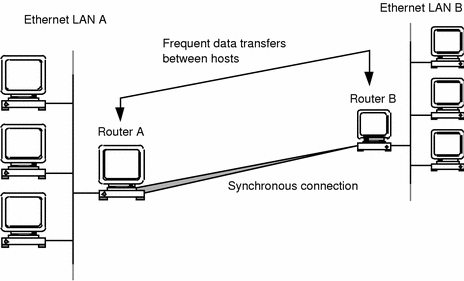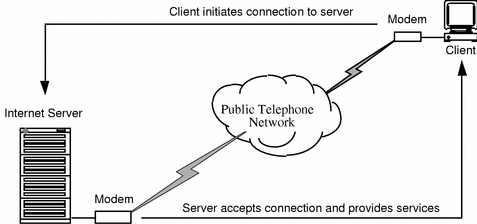Establishing the Physical Connection
Solstice PPP transmits data over full-duplex, bit-serial connections. It supports any of the common serial communications protocols, including EIA-232-E (formerly, RS-232-C), EIA-422, EIA-423, EIA-530, and CCITT V.24 and V.35. The physical connection for Solstice PPP may be either synchronous or asynchronous.
Synchronous Connections
Synchronous connections use independent clocking signals to synchronize the data transmission. They provide a permanent connection between two endpoints, and are typically established over dedicated leased-lines.
You pay for the synchronous connection for the duration of the lease and the cost is independent of the quantity of data transmitted. For these reasons, synchronous connections are best suited to continuous data traffic and are used typically for LAN-to-LAN interconnectivity and bulk transfers of information as shown in Figure 1-2.
Figure 1-2 Synchronous Connection between LANs.

The synchronous connection is established through a synchronous serial interface installed in the host machine. The synchronous connection is established when Solstice PPP is started; therefore, there is no independent connection phase when a PPP link is established over a synchronous connection. Refer to the Solstice PPP 3.0.1 Installation Guide and Release Notes for a list of the synchronous serial interfaces with which Solstice PPP has been tested.
Asynchronous Connections
Asynchronous connections either use information carried in the data itself (software flow control), or handshake signals generated by the serial interface (hardware flow control), to control the data transmission. They provide temporary connections between two endpoints, and are typically established over private and public telephone networks or null modem links.
The cost of the connection is related to the duration of the call and the distance between endpoints. For this reason, asynchronous connections are best suited to transient network traffic, and are used typically for mobile communication, teleworking, and temporary access to Internet servers as shown in Figure 1-3.
Figure 1-3 Asynchronous Connection between Client and Server

The asynchronous connection is established through an asynchronous serial interface installed in the host machine, and a modem which represents the interface between the host machine and the analog telephone network. During the connection phase, the modems at each endpoint communicate to set up the call.
Refer to the Solstice PPP 3.0.1 Installation Guide and Release Notes for a list of the asynchronous serial interfaces and modems with which Solstice PPP has been tested. Configuration information for these modems is contained in the modem database file /etc/opt/SUNWconn/ppp/modems.
You can modify the modems database file to add configuration information for additional modems, provided they support standard Hayes AT commands. Refer to the manufacturers' documentation for details of the commands used to configure your modem.
- © 2010, Oracle Corporation and/or its affiliates
